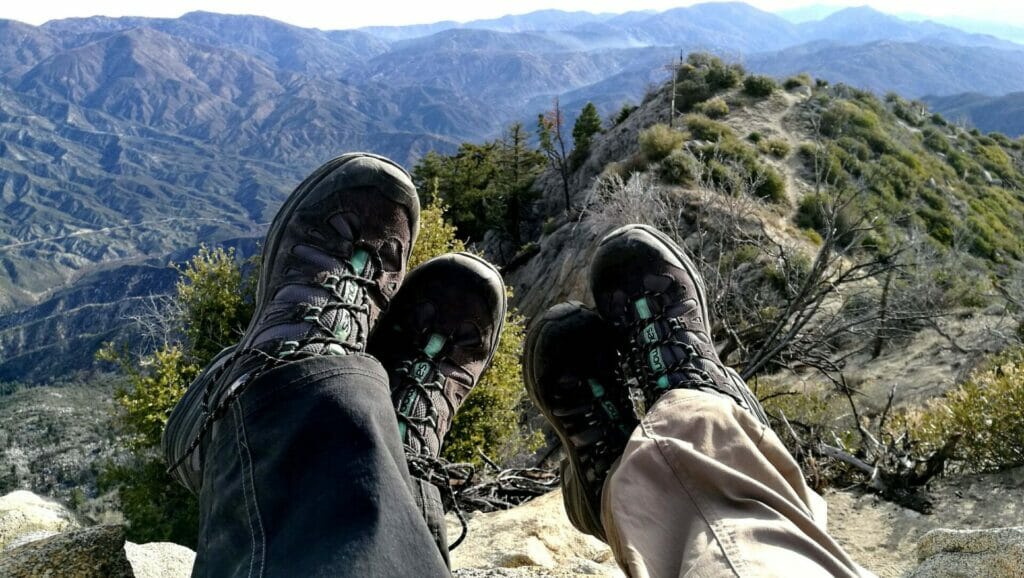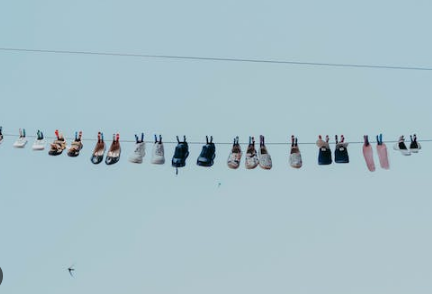How to Get Mildew Smell Out of Hiking Boots – A Complete Guide
Have you ever experienced the unpleasant smell of mildew in your hiking boots after a long, wet hike? If so, you know how frustrating and uncomfortable it is.
I have also experienced mildew in my hiking boots on a few occasions. One time, I went on a hike in a tropical rainforest, and despite my best efforts, my boots got soaked through.
When I returned home, I let them air out, but the musty smell remained. Later, I discovered that mildew had grown on the inside of my boots, which was causing the odor.

But by following some methods, i effectively eliminate the mildew smell and enjoy fresh, odor-free boots. Remember, proper maintenance and cleaning are essential to prolonging the life of your hiking boots and ensuring a comfortable and pleasant hiking experience.
Give these methods a try—I’m confident you’ll be thrilled with the results, just as I was!
How Often Should You Replace Your Hiking Boots?
How To Get Mildew Smell Out Of Hiking Boots?
Mildew is a type of fungus that thrives in damp and humid environments. It’s one of the most common causes of the musty smell that permeates hiking boots. It is a problem that many hikers face, particularly those who hike in wet or humid conditions.
Removing the mildew smell from your hiking boots is crucial for various reasons but you can remover this by following these steps
1. Cleaning
When it comes to hiking, having a comfortable and odor-free pair of boots is crucial. After a long day on the trails, it’s not uncommon for hiking boots to develop a persistent mildew smell. I faced this issue myself and was determined to find a solution.
After trying various methods, I discovered an effective cleaning and washing routine that worked wonders in eliminating the mildew smell from my hiking boots. Now I’ll share my firsthand experience with this method, guiding you step by step so that you can enjoy fresh-smelling boots on your next adventure.

Step 1: Gather the necessary supplies
To begin, you’ll need the following items:
Mild detergent: Choose a gentle detergent suitable for the material of your boots.
Soft-bristled brush: This will be used to scrub away dirt and grime.
Warm water: Prepare a basin or sink with warm water.
Old toothbrush: This will help clean hard-to-reach areas.
Towels: Have a few clean towels ready for drying.
Step 2: Preparing the boots for cleaning
Before diving into the cleaning process, remove the laces and insoles from your boots. If possible, expose the boot’s interior by opening up the tongue and collar to maximize airflow during the cleaning process. This will allow the cleaning solution to penetrate deeper and effectively eliminate the mildew smell.
Step 3: Cleaning the boots
Now it’s time to get your hands dirty. Wet the soft-bristled brush with warm water and apply a small amount of mild detergent. Gently scrub the exterior of the boots, paying extra attention to the areas where dirt and grime tend to accumulate. Use the old toothbrush to clean hard-to-reach nooks and crannies.
Step 4: Tackling the mildew smell
To specifically target the mildew smell, create a mixture of warm water and mild detergent in a basin or sink. Submerge the insoles and laces in this solution and let them soak for about 15-20 minutes. While they soak, use the soft-bristled brush and soapy water to clean the interior of your boots. Scrub away any visible mildew or residue, ensuring you cover the entire interior surface.
Step 5: Rinse and dry
Once you’re satisfied with the cleanliness of both the boots and the insoles, it’s time to rinse them thoroughly. Use clean, warm water to remove all traces of detergent. Ensure you rinse off any soapy residue from the boots’ exterior as well as the insoles and laces.
After rinsing, pat the boots gently with a clean towel to remove excess water. Place them in a well-ventilated area to air dry. Avoid direct sunlight or excessive heat, as this can damage the boots’ material. Once dry, reinsert the insoles and laces, and your boots will be ready for your next adventure!
2. Moisture Wicking Socks
In my personal experience, moisture-wicking socks have been a game-changer when it comes to combating the unpleasant mildew smell in my hiking boots. They effectively reduce moisture, keep my feet dry and comfortable, and prolong the freshness of my boots.

Since incorporating these socks into my hiking gear, I’ve enjoyed odor-free adventures and greater confidence in my footwear. If you’re tired of dealing with smelly hiking boots, I highly recommend giving moisture-wicking socks a try.
The Problem of Sweaty Feet:
Like many hikers, I often struggled with sweaty feet during extended hikes. The moisture produced by my feet was a breeding ground for bacteria and fungi, leading to that persistent mildew smell in my boots. I wanted a practical solution to address this issue.
Discovering Moisture-Wicking Socks:
After some research and recommendations from fellow hikers, I decided to give moisture-wicking socks a try. These specialized socks are designed to pull moisture away from the skin and help it evaporate more quickly, keeping your feet dry and comfortable.
The First Experience:
When I tried moisture-wicking socks for the first time, I was skeptical. However, the results were astonishing. The fabric of the socks effectively absorbed the sweat from my feet, leaving them noticeably drier than with regular socks. This reduced the moisture in my boots and significantly minimized the foul odor.
Breathability and Comfort:
One of the key advantages I discovered with moisture-wicking socks is their superior breathability. The material used in these socks allows air to circulate more freely around my feet, preventing excessive sweating and enhancing overall comfort during hikes. I found that my feet remained fresher and cooler throughout the journey.
Durability and Longevity:
Another aspect that impressed me about moisture-wicking socks is their durability. Despite enduring rough terrains and frequent use, these socks have proven to be highly resilient. The quality materials used in their construction have ensured that they withstand the demands of hiking without losing their moisture-wicking capabilities.
Ease of Maintenance:
Caring for moisture-wicking socks is a breeze. They can be easily washed by hand or machine, and they dry quickly due to their moisture-wicking properties. This convenience adds to their appeal, making them an excellent choice for outdoor enthusiasts who value practicality.
3. Deodorizing spray
With this DIY deodorizing spray, you can tackle the issue head-on and enjoy fresh-smelling boots on your next adventure. Remember to store the spray bottle in a cool, dry place for future use, and repeat the process whenever necessary to maintain odor-free boots.

Step-by-Step Guide:
Step 1: Gather the Ingredients
To create your own deodorizing spray, you’ll need the following items:
Distilled water
White vinegar
Essential oil of your choice (such as tea tree oil, eucalyptus oil, or lavender oil)
Spray bottle
Step 2: Prepare the Mixture
Here’s how I made my DIY deodorizing spray:
Fill the spray bottle halfway with distilled water.
Add an equal amount of white vinegar to the spray bottle.
Add around 10-15 drops of your preferred essential oil. This not only helps neutralize the odor but also imparts a pleasant scent to your boots. I personally used tea tree oil due to its natural anti-fungal properties.
Close the spray bottle tightly and give it a gentle shake to mix all the ingredients.
Step 3: Apply the Spray
Now it’s time to put the deodorizing spray to work:
Start by removing any loose dirt or debris from your hiking boots.
Shake the spray bottle once again to ensure the ingredients are well-mixed.
Hold the boots at a distance and generously spray the mixture inside each boot, focusing on the areas that tend to accumulate odor, such as the toe box and insoles.
For maximum effectiveness, I recommend spraying the boots in the evening, allowing them to air dry overnight. This will give the deodorizing spray enough time to work its magic.
Step 4: Enjoy the Results
When I tried this method, I was initially worried about the efficacy of a simple DIY spray. However, to my pleasant surprise, the mildew smell in my hiking boots significantly diminished after just one application. The deodorizing spray effectively eliminated the odor and left behind a refreshing scent.
4. Air dry
Using the air drying method to eliminate the mildew smell from my hiking boots was a game-changer. Now, I can confidently hit the trails with fresh-smelling boots, knowing that I’ve found a simple, effective, and natural solution.
If you’re facing a similar issue, I highly recommend trying the air drying method and enjoying the benefits of fresh-smelling boots on your next hiking adventure!

Excited about the prospect of salvaging my beloved hiking boots, I decided to give the air drying method a shot. Here’s what I did:
Removed the insoles: I carefully removed the insoles from my boots to facilitate better airflow.
Placed the boots in a well-ventilated area: I chose a spot in my home that had good air circulation, such as near an open window or a fan. Proper ventilation is crucial to ensure the boots dry thoroughly.
Positioned the boots upside down: I placed the boots upside down, ensuring that the interiors received maximum airflow.
Patience is key: I allowed my boots to air dry naturally for several days, avoiding the temptation to expedite the process with heat sources like heaters or hair dryers. Heat can cause damage to the boots, so it’s best to be patient and let them dry naturally.
Not only did my hiking boots regain their freshness, but the mildew smell completely vanished! Here are the benefits I experienced:
Safe and natural: The air drying method is gentle on the boots and doesn’t involve the use of any harsh chemicals or cleaners.
Preserves boot integrity: By avoiding excessive heat or harsh cleaning agents, I ensured that my boots remained in good condition without compromising their quality or structure.
Cost-effective: This method didn’t require any additional purchases or expensive products, making it a budget-friendly solution.
11 Best Cheap Waterproof Hiking Boots
5. Use silica gel packets
Using silica gel packets is an affordable and straightforward solution to combat mildew smells in your hiking boots. Give it a try, and you’ll experience the same satisfaction I did. Say goodbye to unwanted odors and enjoy the great outdoors with confidence!

Step 1: Gather the necessary materials
To begin, you’ll need a few silica gel packets. These small packets contain silica gel, a desiccant that helps absorb moisture and eliminate odors. You can find them in various packaging or even reuse ones you may have received with other products, such as electronic devices or shoes.
Step 2: Prep your hiking boots
Before using the silica gel packets, make sure your hiking boots are clean and dry. Remove any dirt or debris from both the exterior and interior of the boots. Wipe them down with a damp cloth and allow them to air dry completely.
Step 3: Insert silica gel packets
Now it’s time to put those silica gel packets to work! Open each packet and place them inside your boots. Depending on the size of your boots, you may need two or more packets per boot. Make sure the packets are evenly distributed, covering both the toe and heel areas.
Step 4: Leave the packets overnight
Allow the silica gel packets to work their magic overnight. The silica gel will absorb excess moisture and help eliminate the mildew smell. During this time, the packets may become damp or even change color, indicating that they are doing their job.
Can I Wear Hiking Shoes To Work Or School?
Step 5: Remove and replace as needed
In the morning, remove the used silica gel packets from your boots. You may notice that the mildew smell has significantly reduced or even disappeared. If the smell persists, repeat the process with fresh silica gel packets. Remember to dispose of the used packets responsibly.
6. Use boot trees
Using boot trees proved to be an effective and easy solution for eliminating the mildew smell from my hiking boots. By absorbing excess moisture and promoting proper airflow, boot trees help prevent the growth of mold and mildew, ensuring your boots remain fresh and odor-free. Give this method a try, and you’ll be amazed at the results.
Step 1: Purchase Boot Trees
I bought a pair of high-quality boot trees that matched the size of my hiking boots. It’s crucial to choose boot trees made of materials like cedar or absorbent fabrics, as they offer excellent moisture absorption properties and natural odor-fighting abilities.
Step 2: Insert the Boot Trees
After removing my insoles, I inserted the boot trees into my damp boots. The boot trees help maintain the shape of the boots and ensure proper airflow during the drying process.
Step 3: Allow Sufficient Drying Time
I left the boot trees in my boots for several days, allowing them ample time to absorb the moisture and combat the mildew smell. It’s essential to place the boots in a well-ventilated area while they dry.
Step 4: Remove the Boot Trees and Enjoy Fresh-Smelling Boots
Once I was confident that my boots had dried thoroughly, I removed the boot trees and reinserted the insoles. I was thrilled to discover that the mildew smell had completely disappeared, leaving my hiking boots smelling fresh and ready for my next adventure!

14 Best Waterproof Hiking Boots Under $100
What Type Of Cleaner Should I Use To Get Rid Of The Mildew Smell In Hiking Boots?
In terms of cleaners, choose a cleaner that is specifically designed for use on hiking boots and is safe for the materials of your boots. Avoid using harsh chemicals or bleach, as these can damage the materials and cause them to deteriorate more quickly.

A good option is a mild soap and water solution, which helps remove dirt and debris from your boots without damaging them. Mix a small amount of mild soap with warm water and use a soft-bristled brush to gently scrub the surface of your boots. Rinse with clean water and let them air dry completely before wearing them again.
Are Hiking Shoes Suitable For Construction Work?
Can I Use Essential Oils To Remove The Mildew Smell From My Hiking Boots?
Essential oils are effective in removing mildew smells from hiking boots. However, it is important to note that essential oils should be used as a supplement to, rather than a replacement for, proper cleaning and storage practices.
To use essential oils to remove mildew smells from your hiking boots, you can follow these steps.
Before using essential oils, make sure your boots are clean and dry. Remove any dirt or debris from the exterior and interior of the boots and let them air dry completely.
Several essential oils have anti-fungal and anti-bacterial properties that help to eliminate mildew smells. Tea tree oil, eucalyptus oil, and lavender oil are popular choices.
Mix a few drops of your chosen essential oil with water in a spray bottle. Shake well and spray the mixture inside your boots. Make sure to cover all areas of the interior. Let the boots air dry before wearing them again.
Will Hiking Shoes Wear Out Faster If I Use Them For Everyday Wear?


